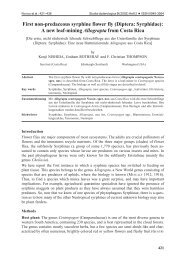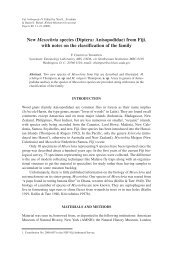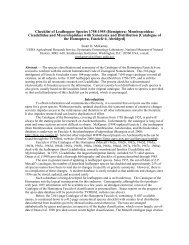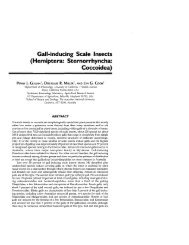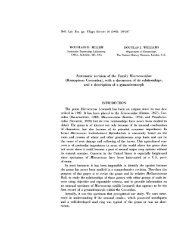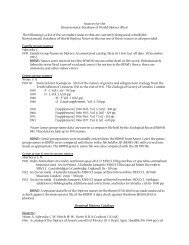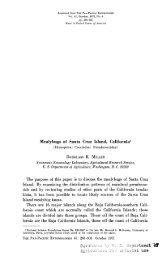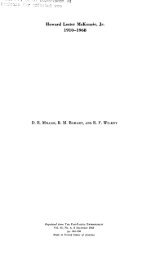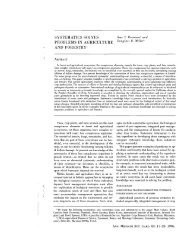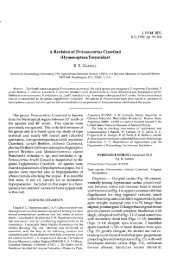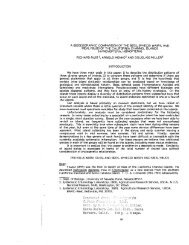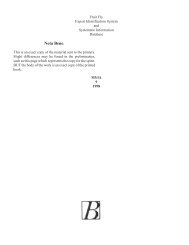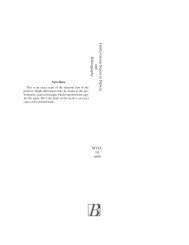A NEW SPECIES OF PUTa AND A PRELIMINARY ANALYSIS OF ...
A NEW SPECIES OF PUTa AND A PRELIMINARY ANALYSIS OF ...
A NEW SPECIES OF PUTa AND A PRELIMINARY ANALYSIS OF ...
You also want an ePaper? Increase the reach of your titles
YUMPU automatically turns print PDFs into web optimized ePapers that Google loves.
28 MIllER & MIllER: PillO KOSZTARABI<br />
30. Antennal segments: (0) 9 or morej (1) 8 or less.<br />
31. Claw denticle: (0) absent; (1) present.<br />
32. Trochanter sensoria on each surface: (0) more than 2;<br />
(1) 2.<br />
FIRST INSTAR<br />
33. Median longitudinal line of abdominal setae: (0) absent;<br />
(1) present.<br />
34. Proximal marginal femoral seta: (0) absent; (1) present.<br />
35. Ostioles: (0) absent; (1) present.<br />
36. Simple disk pores: (0) absent; (1) present.<br />
37. Spiraled trilocular pores: (0) absent; (1) present.<br />
38. Antennal segments: (0) 6-segmented; (1) 7-segmented.<br />
RESULTS <strong>AND</strong> DISCUSSION<br />
Two equally parsimonious trees were found (length = 86, CI = 0.61,<br />
RI = 0.86). The two trees differed only in the placement of Pityococcus<br />
ferrisi McKenzie. In one tree, P. ferrisi was placed as the sister group of<br />
Stem 6 (Fig. 8): In the second tree, this species was placed as the sister<br />
group of Stem 5 (Fig. 8). We prefer the first tree since it is defined by<br />
the presence of ostioles and medial circuli. These are both complex<br />
characters that we cannot easily envision developing independently.<br />
However, this preference is a subjective decision.<br />
Our subsequent discussion is based on the Nelson consensus tree<br />
shown in Fig. 8. This tree contains a trichotomy immediately above Stem<br />
3. The consensus tree is preferred over the other two parsimonious trees<br />
because of the trichotomy of Stem 4 (Pityococcus ferrisl) + Stem 5 +<br />
Stem 6. We feel this best reflects the current unresolved placement of<br />
Pityococcus ferrisi. Characters justifying the monophyly of selected<br />
higher-level clades are presented below organized by the stem numbers<br />
given in Fig. 8. Bracketed numbers refer to the characters given above.<br />
Stem 1 (Fig. 8) represents the primitive condition for characters in the<br />
matrix.<br />
Stem 2. Adult male with: preocular ridge ventrally complete [9.b];<br />
more than 2 pairs of eyes [11.lJj dorsolateral tail-forming pore clusters on<br />
segment 8 [13.a]j 2 halter setae [14.1]j preocular and postocular ridges<br />
separate [19.1]; anal ring present on dermal surface [27.1]j adult female



